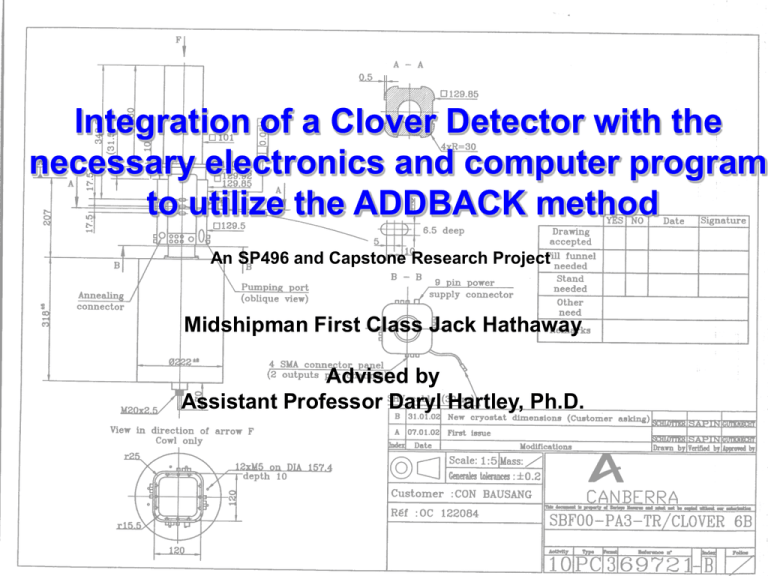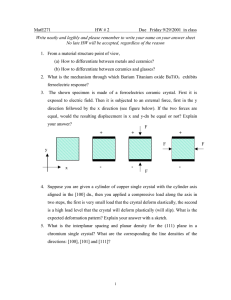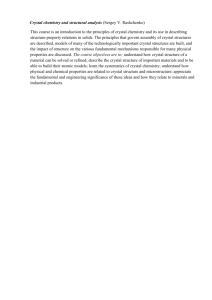Integration of a Clover Detector with the
advertisement

Integration of a Clover Detector with the necessary electronics and computer program to utilize the ADDBACK method An SP496 and Capstone Research Project Midshipman First Class Jack Hathaway Advised by Assistant Professor Daryl Hartley, Ph.D. Co60 Emitted Beta Particle Unstable Co60 Beta Decay 1173 γ-ray Emitted Gamma rays Unstable Ni60 Energy 1332 γ-ray Stable Ni60 Time So how do we ‘see’ all of this happening? What kind of detector do we need? When my advisor was a student… Bell bottoms were cool… The Beetles first appeared on stage… …and nuclear physicists used Sodium Iodide (NaI) Detectors… High Density = Great Efficiency Poor Energy Resolution from detection system While I was busy watching Transformers… Nuclear physicists developed Germanium (Ge) Crystal Detectors… Low Density = Low Efficiency Great Energy Resolution from detection system Can we have the Low Density = Low Efficiency best of both? Great Energy Resolution from detection system High efficiency and good resolution? Clover detector An array of four Germanium Crystals, physically and electronically independent 25 cm Clover Detector Source Location Anode Cathode Channel Number The Basic Electronics: Spec Amp ADC Crystal 1 Number Of Counts Crystal 1 0 Crystal 2 600 Crystal 3 0 Crystal 4 0 KMAX Program Crystal 2 Number Of Counts The KMAX program displayed 5 counts, but there were only 3 Events…. Channel Number Channel Number Were there 5 gamma rays orCrystal only Crystal 3 4 3? Number Of Counts Number Of Counts Channel Number Channel Number Mission: Utilize the Clover Detector as an array rather than four single detectors to give the researcher the best data possible Solution: Integrate the Clover Detector into the necessary electronics and create a computer program to utilize the ADDBACK Method What is ADDBACK? Addback Flash created by Dave Campbell, Florida State University Coding ADDBACK Computer Input Channel Number Crystal 1 0 Crystal 2 600 Crystal 3 0 Crystal 4 0 Step 1: Define an event Event 1 Each event corresponds to a single gamma ray interacting with the detector. One Gamma ray = One Event = One Coincidence Window Step 2: Creating an electronic Coincidence Window Output group 1 Spec Amp Fast Amp Output group 2 Logic ‘OR’ Gate Gate Delay Generator Output to Computer Event 1 Channel Number Crystal 1 600 Crystal 2 0 Crystal 3 400 Crystal 4 200 1 2 34 ADC Gate Inputs Analog to Digital Converter Step 3: Applying calibrations Crystal 1 Counts Channel Number Energy Event 1 Channel Number Crystal 1 600 Crystal 2 0 Crystal 3 400 Crystal 4 200 Crystal 2 Counts Channel Number Energy Crystal 3 Counts Channel Number Energy Crystal 4 Counts Channel Number Energy Step 4: Executing ADDBACK Event 4 1 2 3 Channel Number Energy Crystal 1 600 1350 0 560 1332 0 Crystal 2 0 800 0 746 Crystal 3 400 1150 0 412 1173 0 Crystal 4 200 0 210 201 0 251 ADDBACK = 1332 560 0 + ++ 0746 0+ 0 ++ 1173 +412 00+++0+251 0=201 =1332 =1173 =997 1173 Totals ADDBACK Separate Crystals Event 1 1173 Event 1 560, 412, 201 Event 2 1332 Event 2 1332 Event 3 1173 Event 3 1173 Event 4 997 Event 4 746, 251 Peak to Background 3:1 ratio (actual 25%) 2:5 ratio (actual 14%) Results Results Future Goals - Longer Runs - Proton Resonance - Polarization Acknowledgements Advisor: Assistant Professor Daryl Hartley, Ph.D. Witty quips and technical advice: Professor Jeff Vanhoy, Ph.D. Stunts and Modeling: MIDN 1/C Drew Barker, roommate Scratch-work slide 125 250 400 650 Background Detector pictures? Clover Picture The Basics: Coding ADDBACK Event 3 1 2 Spec Amp ADC Crystal 1 Number Of Counts KMAX Program Crystal 2 Number Of Counts The KMAX 1 Count program displayed 5 counts, 1 Counts 2 Count but there were only 3 Events…. Channel Number Channel Number Were there 5 gamma rays orCrystal only Crystal 3 4 3? Number Of Counts 1 Count Channel Number Number Of Counts 1 Count Channel Number Double outputs, same signal from each crystal Pre-Amp Interior to the Clover Detector What is a Coincidence Window? 32 microseconds Ekg thingermabober of science! Gate Delay Generator ADC Gate Input Output Question slide on the PMT NaI detectors






